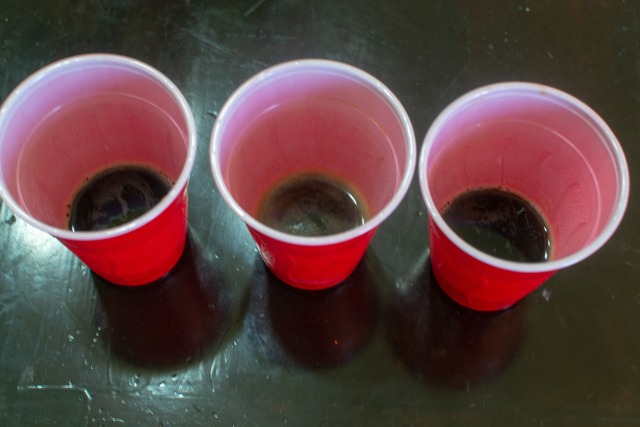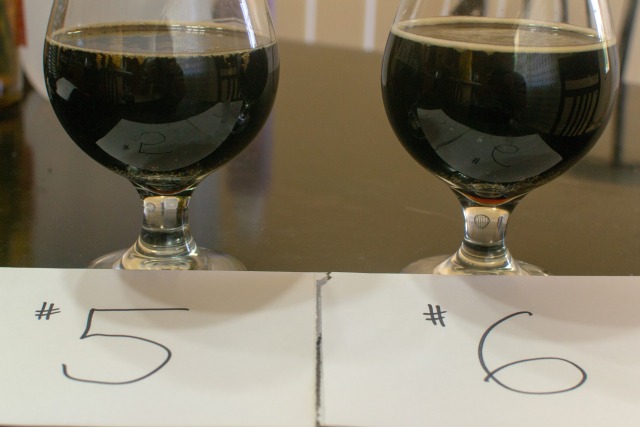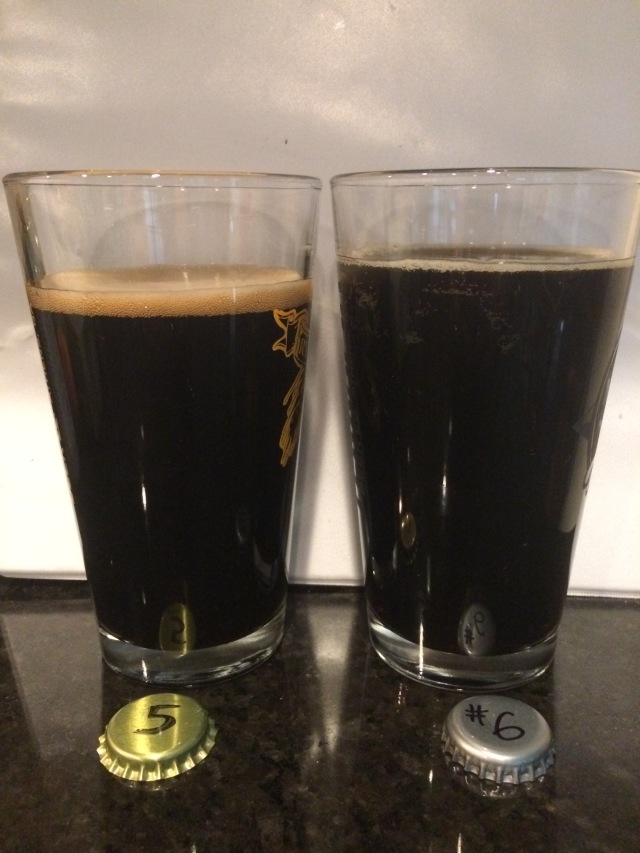This post is one in a series following six brewers collaborating to each make a small adjustment to a single recipe in order to improve it, then pass it along to the next brewer. We hope to learn more about the art of recipe creation as we see how other brewers approach the same recipe. The rest of the comparison tastings for this series can be found here.
The recipes for the beers being compared below are as follows:
| Iteration 5 | Iteration 6 | |
| Base Malt | 69.2% 2-row | 69.2% 2-row |
| Specialty Malt 1 | 10.8% Victory | 10.8% Victory |
| Specialty Malt 2 | 7.8% Roasted Barley | 7.8% Roasted Barley |
| Specialty Malt 3 | 4.4% Chocolate Malt | 4.4% Chocolate Malt |
| Specialty Malt 4 | 7.8% Flaked Barley | 7.8% Flaked Barley |
| 60 min. hop | Nugget: 41.5 IBUs | Nugget: 45 IBUs |
| 5 min. hop | Willamette: 3 IBUs | Willamette: 3.6 IBUs |
| Yeast | US-05 | White Labs Irish Ale Yeast (WLP004) |
| OG | 1.064 | 1.065 |
| FG | 1.020 | 1.018 |
| ABV | 5.8% | 6.2% |
Taster: M. Rasmussen
My brewing partner and I compared these beers as the mash water warmed up for a batch of summer pale ale. However, before comparing the beers directly we decided to try something else first. With my wife’s help, we did a blind triangle test with two cups of Iteration 6 and one cup of Iteration 5. The cups were opaque so we couldn’t see a difference in appearance, but we were both able to confidently and correctly identify the odd beer out with just the aroma. The two versions were strikingly different in aroma and flavor. After the blind test, we sat down with the full glasses and took our notes.

Iteration 5:
Appearance: Iteration 5 pours with an immediately dissipating tan head. A thin ring of tan bubbles remain and lace the glass throughout drinking. The beer is an opaque black that remains constant when help up to the light. Very light bubbling is apparent, showing a moderately low carbonation level.
Aroma: Sweet and fruity notes stand out at first. A dark cherry and/or plum come to mind. Digging through the heavy fruit aroma I also get notes of bitter roasted malts. The intense fruity aroma is slightly reminiscent of a red wine.
Mouthfeel: Iteration 5 has a medium body, but there’s a strange thinness to it. The low carbonation level may be contributing to the lack of “weight” it carries in the mouth.
Flavor: The aroma doesn’t lie with dark cherry coming through strongly. I also get a bit of an apricot flavor. The malt profile is roasted and nutty. Not a lot of chocolate or coffee come through. Fruit is the main character in this story, if you haven’t caught on yet.
Aftertaste: There’s a spicy bitterness when the fruity flavors subside. It’s not unpleasant, but it’s not something you’d expect in a typical stout. To me, it’s the most intriguing aspect of this beer. I’m not quite sure if it’s the hops finally making themselves known, or if it’s a result of the high amount of dark malts.

Iteration 6:
Appearance: There’s virtually no difference between Iterations 5 and 6 at first glance. They are both the same pitch black in the glass. Iteration 6 differs with a lighter, off-white head that remains slightly longer that Iteration 5. The carbonation bubbles are smaller and site much closer together. More bubbling is apparent as well.
Aroma: Iteration 6 has a much more subtle aroma. Yeasty esters and light roasted notes are about all that’s going on. The light roasted notes are nearest to a very blonde coffee roast.
Mouthfeel: Whatever was lacking in the mouthfeel in Iteration 5 is there in abundance in Iteration 6. It’s the same medium body, but the smaller carbonation bubbles give a pillowy texture on the tongue. It feels heavier in the mouth, but smoother.
Flavor: There’s a lot going on with the flavor profile in Iteration 6. Stone fruit is apparent, but it has a lot of close friends this time. Blonde roast coffee and creamy milk chocolate are at the forefront of the flavor profile, while caramel and darker coffee notes fill in between the spaces. The flavor profile is exactly what you would expect in a stout.
Aftertaste: The caramel and fruity notes linger the most after swallowing. I’m not sure, but I think I get a slight hop bitterness once the other flavors subside.
I am very happy with the recipe change I made. It was quite clear to me that US-05 had taken this malt bill as far as it could, and we needed to bring in an expert in the field. In my comparison, the new yeast had a positive impact on every aspect but appearance. However, although the flavor complexity was much improved, the aroma profile was much more subdued. I’d like to see the next iterations tackle the lack of any hop character, poor head retention and weak aroma. I’m very excited to see where the crew goes from here.
Taster: C. McKenzie
Iterations 5 and 6 were both black in appearance. Iteration 5 had a medium, tan head with moderate persistence, while Iteration 6 poured with a low-moderate head that was off-white/tan and disappeared quickly.

Iteration 5 had a strong aroma of dark chocolate and coffee. There were also notes of toast and dark fruit—plum or cherry. Iteration 6 had a strong roast character to the scent and also had a touch of vanilla and, perhaps, even bourbon.
Iteration 5 tasted of coffee, toast, and dark chocolate. Iteration 6 had a smooth roasted taste, toast flavor, and a hint of chocolate as it warmed.
Overall, Iteration 6 seemed to me, at first, lighter in body; however, I realized that I was mistaking the smooth character of the flavors for having a lighter body. I’d compare the two beers to the difference in smoothness between coffee made with a French press and that made with a standard drip coffee maker. Iteration 6 was definitely smoother and easier drinking, though it still had the heft to it that a stout should.
